What Is a Gantt Chart? Modern Project Management for Creative Teams (2025 Guide)
Want to know what is a Gantt chart? This guide explains Gantt charts for creative teams - plus tips, visuals, and agency workflows!

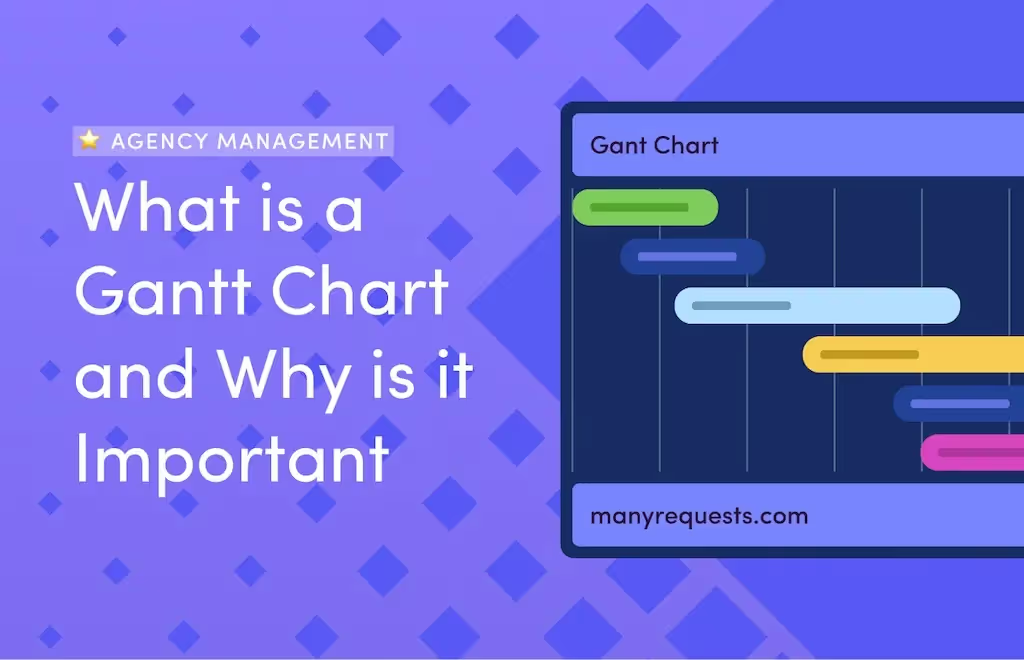


Before Figma boards and Kanban cards, the Gantt chart was the primary project management tool creative teams used to track client projects. But this tool is much older than you might think. Older than the Internet, in fact!
Here’s a quick backstory:
In the late 1800s, Polish engineer Karol Adamiecki sketched out an early version of the Gantt chart but called it “Harmonogram.” Decades later (in the early 20th century), an American engineer, Henry Grant, inspired by Adam’s work, created a similar, but more advanced tool called the “Gantt chart” to help supervisors monitor project progress and ensure tasks are completed before they’re due.
Today, their contributions form the modern Gantt chart we know.

In this article, I’ll explain the benefits of Gantt charts and how to create one to manage client projects and improve your creative workflow.
A Gantt chart is a visual representation of a project that shows the timeline of tasks involved, their start and end dates, and dependencies. It helps to outline task flow so that your team can see what’s assigned to them and complete their work within the specified period.
This is how it looks:
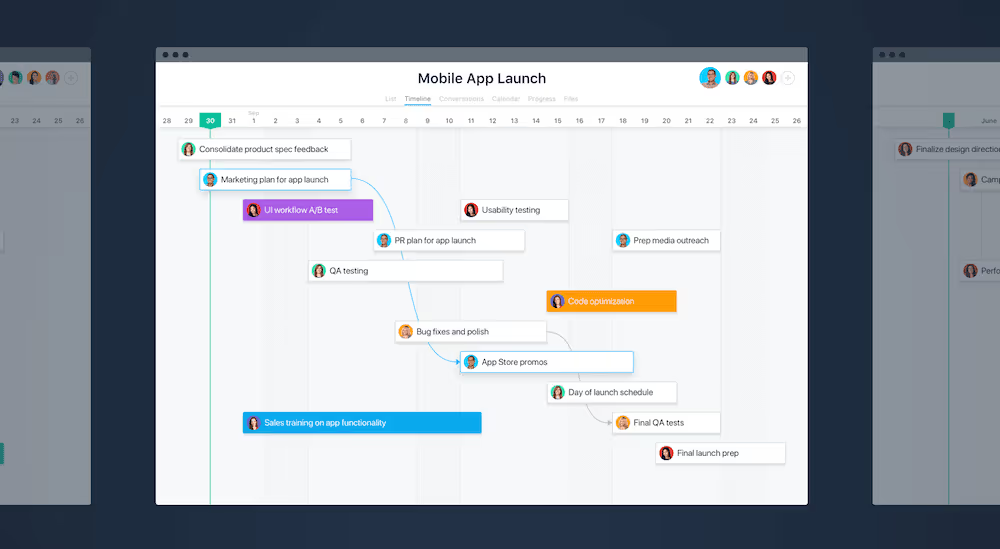
Tracking your project in this way allows you to foresee potential hiccups and correct them before they escalate. This preventive approach helps you to:
In a Gantt chart, all the tasks are listed on the chart's vertical axis.
Each task is broken down into manageable subtasks and includes vital details such as start and end dates, duration, assigned team members, client briefs, and project budget if necessary. This structured view helps teams stay organized and ensure nothing slips through the cracks. Here’s what it looks like:

You’ll find the project’s duration on the horizontal axis, often listed with dates or time intervals. The tasks are shown as horizontal bars that stretch from the start to the end date, like this:

The lines on the task bars are called dependencies, and they’re used to show relationships between tasks, such as which task should be completed before another. For example, a dependency line would connect the two if “Design Mockup” must be finalized before “Client Review” starts. This is how it looks:

This simple visual layout makes it easy to:
Gantt charts are commonly used in project management. It’s an easy way for creative teams to map out client projects, estimate delivery time, and manage quality assurance across each project phase. It’s also used for project management in other industries such as:
Gantt charts are popular in the construction industry, where projects span over a year, five years or more. The charts provide an easy way to organize work that must be accomplished at certain intervals and help coordinate work between many contractors.
For instance, for a new commercial building project, the project manager will lay out a schedule using a Gantt chart to map out key phases such as site preparation, foundation work, plumbing, electrical wiring, and finishing. Each contractor and stakeholder can see their exact roles and deadlines so they can prepare accordingly.
Gantt charts are widely used in the Information Technology field, where large software rollouts or hardware upgrades can take considerable coordination and time. As the project progresses, you can monitor team members and ensure everyone remains on track to meet upcoming deadlines, as shown on the Gantt chart.
The Gantt charts also make it easy to assign responsibilities to individual team members so that they can see the tasks they’re responsible for and when they need to be done. As the project progresses, you can track the progress of each team member and ensure everyone meets their deadlines.
For project managers to manage multiple jobs at once, Gantt charts help you stay up to date on the progress of each project. The chart gives a centralized view of each project's timelines, making it (much more) easier to manage priorities, allocate resources, and get client/stakeholder buy-in faster.
Take this Gantt chart, for example.

Each task has a colored bar across the timeline showing the start and end date, progress percentage, and status tags. This way, you can visualize the entire project and simultaneously manage time, resources, and team responsibilities.
One of the major problems creative agencies face is keeping teams focused on their work and ensuring they meet expectations.
Each project often comes with overlapping tasks (think ideation, concept, and design), and it’s easy for team members to lose track of what needs to be done now and next. This leads to missed deadlines, last-minute changes, and worse, client disappointment.
A Redditor (pip-whip) confirmed that the top challenges in managing a creative team stem from misalignment and poor project management:

These issues can easily be mitigated or solved completely using a Gantt chart. For instance, say you just landed a branding project for a tech startup. Instead of juggling between Slack and long email threads, you can use a Gantt chart to map out the entire workflow, like this:
Other benefits are:
Gantt charts provide a clear, high-level view of the entire project lifecycle. Instead of guessing where things stand, you and your team members can see exactly what’s in progress, what’s coming up next, and how each task connects to the bigger picture.
This makes it easier to predict bottlenecks, manage overlapping deliverables, and set realistic timelines for work reviews or iterations. It also gives clients insight into what’s happening behind the scenes.
If you manage a medium or large agency, resource management is one of the issues you're likely to face. Agency Analytics reviewed 121 agencies and discovered that 11% struggle with executing client deliverables due to poor resource management and miscommunication.

With Gantt charts, you can visualize each team member’s workload and quickly identify if they’re overworked. For example, if your lead designer is overloaded and the junior designer has free time, you can reassign tasks accordingly. This keeps your team members productive and helps you stay abreast of client projects.
With a Gantt chart, you don’t have to wait until it’s too late to realize something’s off track. Its real-time tracking feature allows you to monitor project progress as it happens.
For instance, if a task starts to slip or a resource becomes unavailable, you can quickly adjust timelines, bring in additional support, or reprioritize tasks. This agility makes it easy to keep clients up to speed and make informed decisions when necessary.
Follow these steps to create a Gantt chart for your creative agency:
Before you create a Gantt chart, you need to understand what the project is all about. This is the foundation of any successful Gantt chart, and without it, the tool is only as good as a visual to-do list.
A clear scope outlines key objectives, deliverables, timelines, and potential roadblocks that’ll arise during the process.
For instance, if you want to develop a brand identity for a new client, the project scope may include tasks such as:
By mapping out the project scope, you (and your team members) will better understand the real flow of work, what’s expected, and the resources needed to successfully deliver each part of the project.
To create an effective project scope, communicate with internal teams and stakeholders. The last thing you want is to sketch a project plan that is different from your client's expectations or team members' capacity.
So, it's best to bring everyone on the same page from the outset to avoid miscommunication when the project kicks off.
That said, ask questions like:
This is also the perfect opportunity to clarify what needs to be delivered, when it should be delivered, and how.
The next step is to break down your project into the tasks that need to be finished for completion. Here, you can use a Work Breakdown Structure (WBS) tool to segment the project into smaller, manageable tasks. Each component represents a task or group of related tasks (called dependencies) that contribute to a larger deliverable.
For example, if you want to work on a website redesign for your client, one of the major deliverables can be homepage redesign. The work breakdown structure for this task will be:
The WBS provides a visual hierarchy of the project and makes it easy to understand the relationship between tasks and how they contribute to its overall success. This makes it easy to assign roles to the right team member, organize your workflow, and allocate resources accordingly.
Also, to create a high-quality work breakdown structure, you need to add:
Tip: Before building your Gantt chart, use ManyRequests as a Work Breakdown Structure Tool to organize and break down complex client projects into smaller, manageable tasks.
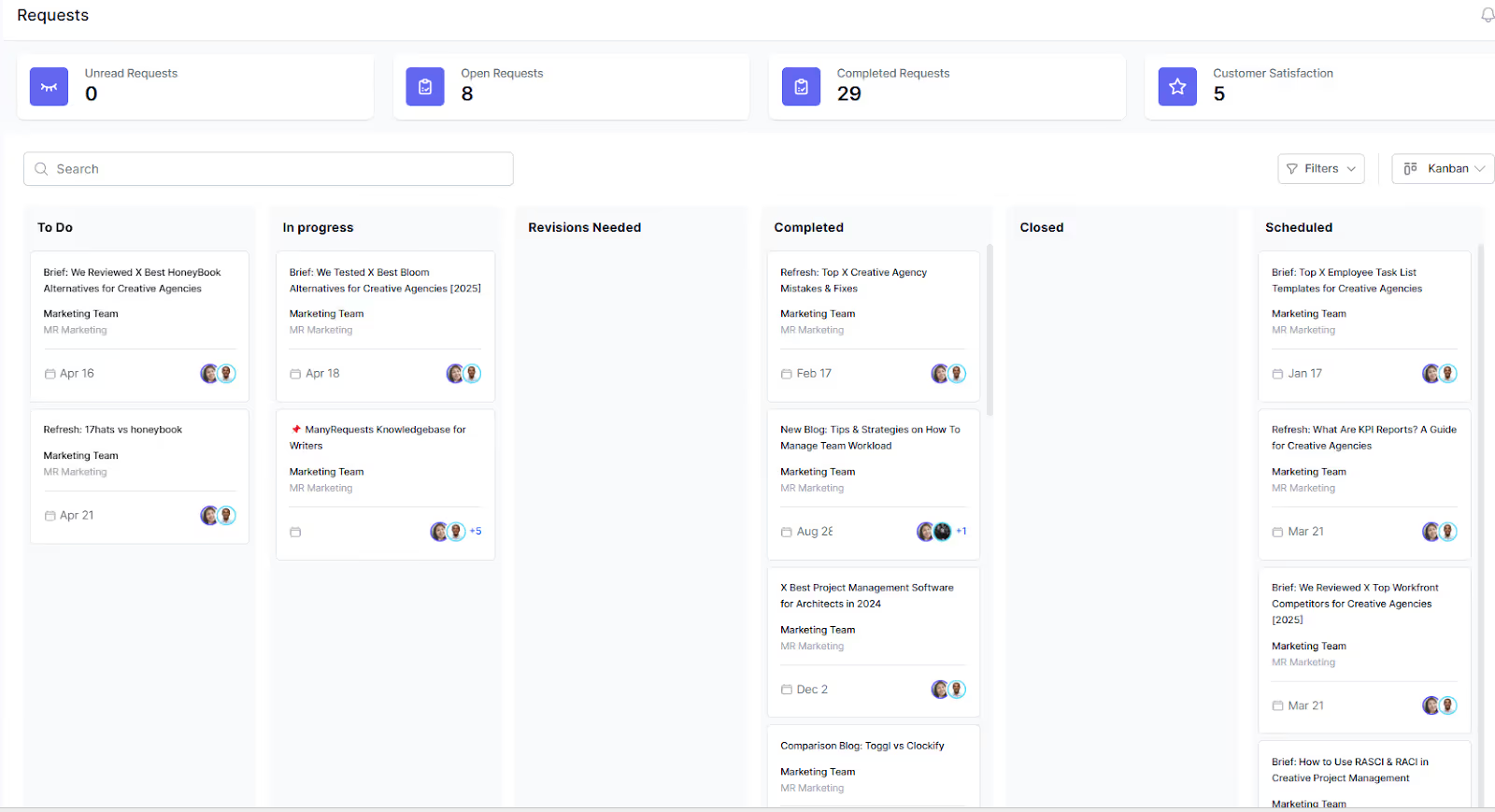
With this, you can map out each phase, such as discovery, design, revisions, and delivery, into sub-tasks, assign them to the right team members, add deadlines, and use the design annotation feature to leave comments directly on the project, like this:
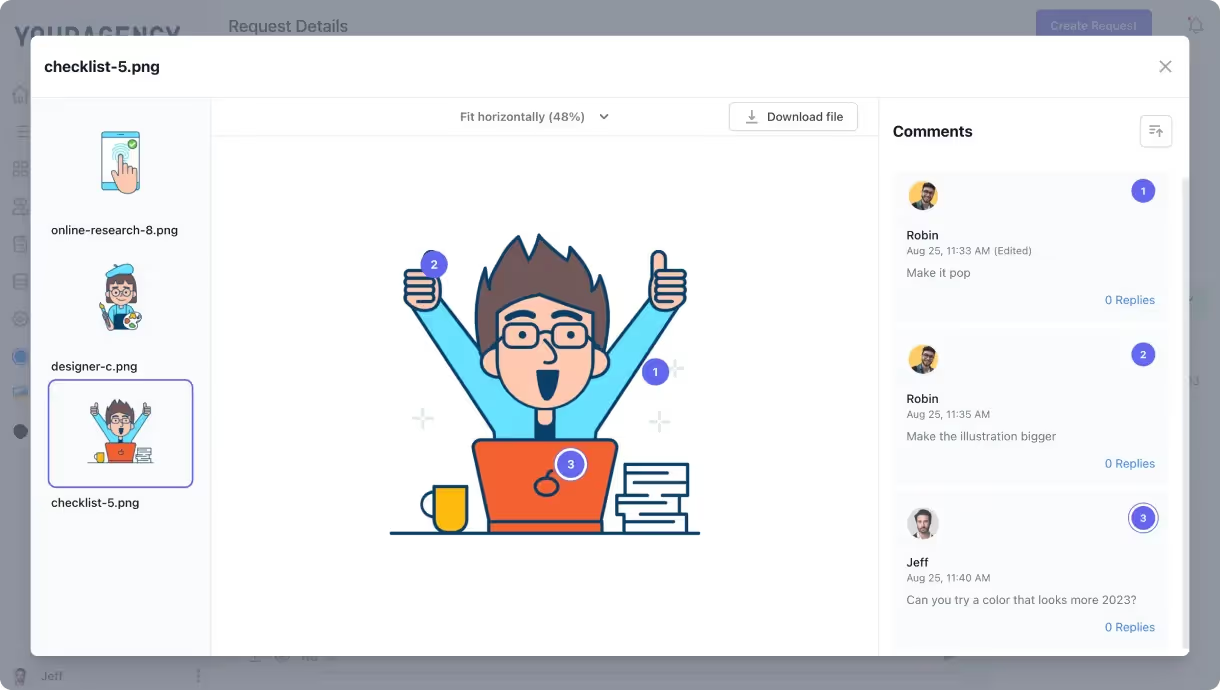
Once the project is broken up into tasks, it’s time to set milestones and deadlines for each. You will have an overall deadline for the project, so set reasonable due dates for the tasks to ensure your project stays on schedule.
If a task goes over the allotted time, the Gantt chart will reflect that and show how it affects the other tasks down the line.
Once you have a good list of tasks, it’s time to assign them an owner who will be responsible for completing that task within the time frame. Ensure there is a good transfer of information and that your team members understand exactly what needs to be done.
Once the team member finishes the task, it will be marked as completed, which should be reflected in the project's overall progress.
Milestones are key achievements in your project timeline that help you to measure progress. Think of them as mini-goals that can be at the end of each task to ensure the project is progressing and everything is on track. For example, in a branding project, a milestone could be “Final Design Approved” after the revision and iteration stage.
A Gantt chart is designed to be a flexible tool that showcases project progress in real time. This means it should be updated as tasks are completed or if issues arise. The best part about Gantt charts is that they can show delays, where they happen, who is responsible, and how they affect the project as a whole.

Keeping this information as up to date allows you to have a bird's eye view of tasks and react preemptively in case of delays.
A Gantt chart is most useful when you need a visual timeline of your client project, most especially when the success of one task depends on the completion of the other. Other use cases are:
Although the Gantt chart is an excellent work management tool, it doesn’t fit all use cases. Here are scenarios where you don’t need a Gantt chart:
Gantt charts make your workflow easier by providing a clear and visual way to keep track of your projects. It allows you to see how the project will proceed and what needs to be done prior to completion, eliminating second guesses as to what's next.
That said, not every project needs one. A kanban board or checklist might be all you need if your workflow is flexible or straightforward. However, a Gantt chart becomes non-negotiable once your projects start scaling, involve task dependencies, or require more team members.
Luckily, you can use ManyRequests to map out project tasks for your Gantt chart and assign them to teams/freelancers so that they can complete their deliverables in time. Each team can see which task they’re assigned to, the owner of the project, and the status in one dashboard:
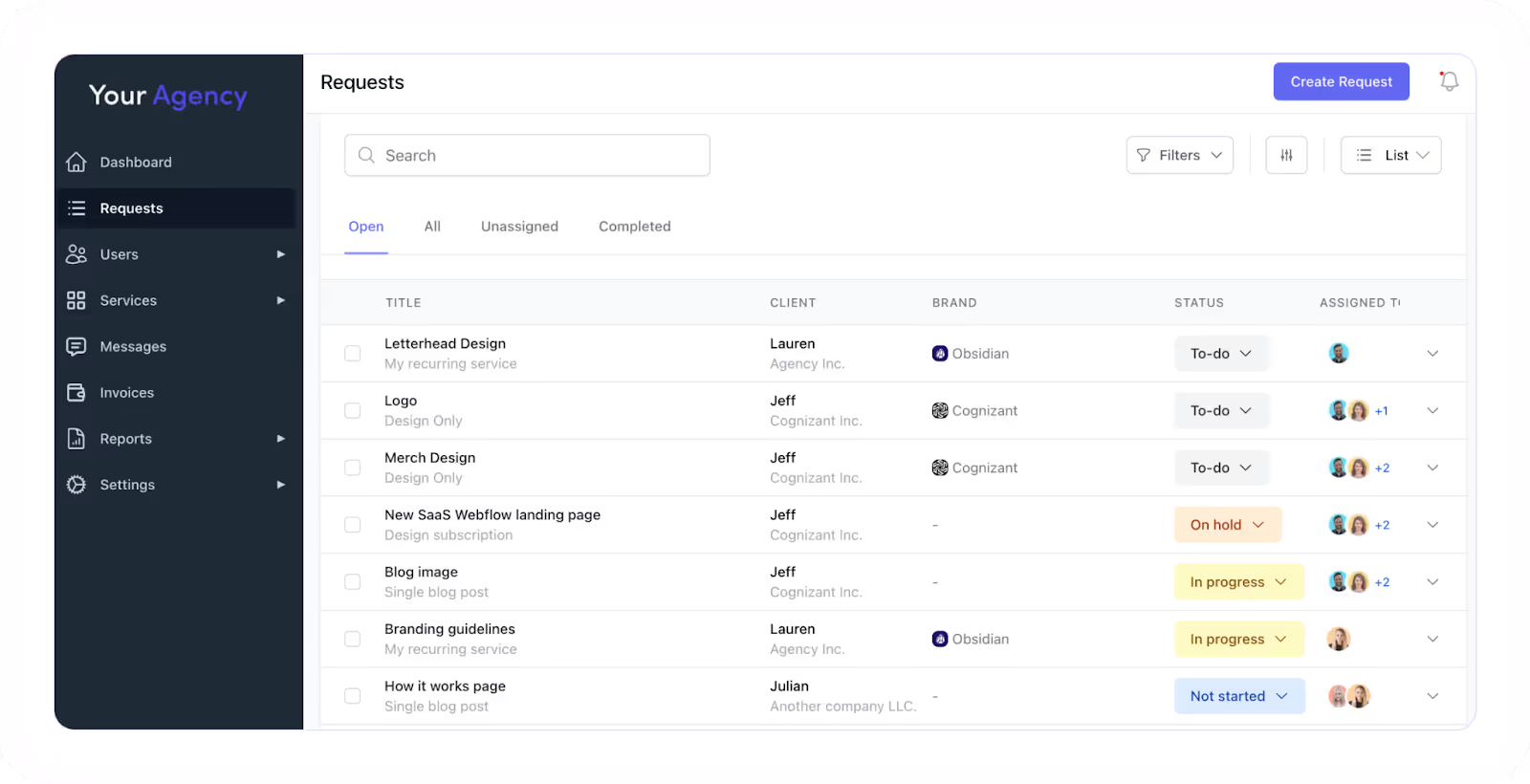
The best part? You don’t need a credit card to get started! Sign up for our 14-day free trial to get started now.
A Gantt chart is a visual representation of multiple projects happening at the same time or scheduled for a later time, allowing you to see what's coming up visually rather than relying on memory.
If you need to work on multiple similar projects while keeping an eye on who's responsible for getting things done, a Gantt chart allows you to lay these out in a visual timeline so that you always know what's next and how long each project should take.
Yes. A Gantt chart doesn't just provide you with a visual timeline at the moment of production. It allows you to look back and analyze potential bottlenecks before they affect the overall project.
Originally Published: April 18, 2021